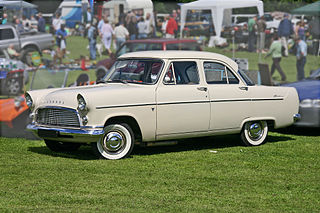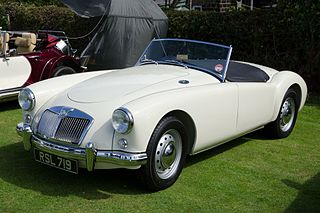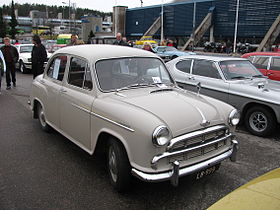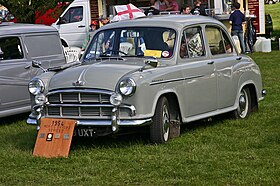
The Ford Consul is a car that was manufactured by Ford of Britain from 1951 until 1962. The name was later revived for a model produced by Ford in both the UK and in Germany from 1972 until 1975.

The Morris Minor is an economy car produced by British marque Morris Motors between 1948 and 1971. It made its debut at the Earls Court Motor Show, London, in October 1948. Designed under the leadership of Alec Issigonis, more than 1.6 million were manufactured in three series: the Series MM, the Series II, and the 1000 series.

The MGA is a sports car that was produced by MG from 1955 until 1962.

The Riley RM is a series of executive cars and compact executive cars that were made by Riley Motors from 1945 until 1955. They were the last models developed independently by Riley before its parent company, Nuffield, merged with Austin to form BMC. The RM series was produced in Coventry until 1949, when production moved to the MG works at Abingdon. Until 1952, models were marketed as the Riley 1½ Litre and the Riley 2½ Litre. the term RM has been used retrospectively to encompass models produced before 1952.

The Austin A40 Farina is a small, economy car introduced by Austin in saloon (1958) and A40 Countryman (1959) estate versions. It has a two-box body configuration. It was badged, like many before it, as an A40, consistent with Austin's naming scheme at the time, based on the approximate engine output in horsepower; and to distinguish it from other A40 models, it was also given a suffix name – this one being the Farina, reflecting the all-new design by Italian Battista Farina's Pinin Farina Turin studio.

The Austin Cambridge is a medium-sized motor car range produced by the Austin Motor Company, in several generations, from September 1954 through to 1971 as cars and to 1973 as light commercials. It replaced the A40 Somerset and was entirely new, with modern unibody construction. The range had two basic body styles with the A40, A50, and early A55 using a traditional rounded shape and later A55 Mark IIs and A60s using Pininfarina styling.

The MG Magnette is a car that was produced by MG between 1953 and 1968. The Magnette was manufactured in two build series, the ZA and ZB of 1953 through to 1958 and the Mark III and Mark IV of 1959 through to 1968, both using a modified Wolseley body and an Austin engine.

The Wolseley 4/50 and similar 6/80 were Wolseley Motors' first post-war automobiles. They were put into production in 1948 and were based on the Morris Oxford MO and the Morris Six MS respectively. The 4-cylinder 4/50 used a 1476 cc 50 hp version of the 6/80 engine, while the 6/80 used a 2215 cc 72 hp straight-6 single overhead cam.

The Wolseley 15/60 is an automobile which was produced from 1958 to 1961, and then, as the Wolseley 16/60, from 1961 to 1971. The 15/60 was the first of the mid-sized Pinin Farina-styled automobiles manufactured by the British Motor Corporation (BMC). Launched in December 1958 as part of BMC's Wolseley brand, the design would eventually be shared with seven other marques. All of the cars were updated in 1961 with a larger engine and new model designations. The Wolseley 16/60 was the last, in production until 24 April 1971.

The Austin Westminster series are large saloon and estate cars that were sold by the British manufacturer Austin from 1954, replacing the A70 Hereford. The Westminster line was produced as the A90, A95, A99, A105, and A110 until 1968 when the new Austin 3-Litre took its place. Essentially badge-engineered versions of the Farina Westminsters were also produced using the premium Wolseley and Vanden Plas marques. 101,634 Westminsters were built.

Morris Oxford is a series of motor car models produced by Morris of the United Kingdom, from the 1913 'bullnose' Oxford to the Farina Oxfords V and VI.
The Morris Isis name was first briefly used by Morris Motors Limited on a 6-cylinder car made from 1929 until 1931. It was resurrected on a new 6-cylinder midsize car from the British Motor Corporation in the 1950s to replace the Morris Six MS.
Morris Cowley was a name given to various cars produced by Morris from 1915 to 1958.

The Daimler Conquest is an automobile which was produced by The Daimler Company Limited in the United Kingdom from 1953 to 1958. Based on the Lanchester Fourteen, the Conquest replaced the Daimler Consort. Sales were affected by increasing prices and by the fuel shortage caused by the Suez Crisis, and production ended by January 1958, before a replacement model was in production.

The Morris Ten is a medium-sized car introduced for 1933 as the company's offering in the important 10 hp sector of the British market. It continued through a series of variants until October 1948 when along with Morris's Twelve and Fourteen it was replaced by the 13.5 hp Morris Oxford MO.

The Humber Hawk is a four-cylinder automobile manufactured by British-based maunufacturer Humber Limited from 1945 to 1967.

The Vauxhall Wyvern is a medium-sized family car introduced by Vauxhall in 1948 as a successor to the Vauxhall 12. The name comes from the mythical beast the wyvern, and may be due to a misidentification of the heraldic griffin on the Vauxhall badge.

Morris Oxford Series MO is a car produced by Morris Motors of the United Kingdom from 1948 to 1954. It was one of several models to carry the Morris Oxford name between 1913 and 1971.

The Morris Oxford Farina is a series of motor car models that were produced by Morris of the United Kingdom from 1959 to 1971. The Farina name coming from the Italian design studio employed for styling.

Morris Oxford is a series of motor car models produced by Morris Motors of the United Kingdom, from the 1913 bullnose Oxford to the Farina Oxfords V and VI. The manufacture of Morris's Oxford cars, named by W R Morris after the university town in which he grew up, would turn Oxford into an industrial city.




















